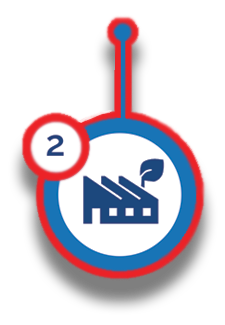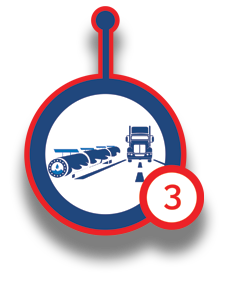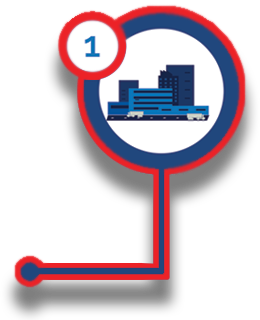Scarcity Zero
Generates
Acts As
Renewable Cities
Integrating renewables directly within city infrastructure allows unrivaled deployment opportunities that minimize distance from generation to consumption. This avoids the need to buy expensive land and lays the groundwork to build smart electric grids. It can also transform cities into energy-generating nodes on a national network - multiplying power generation capacity while minimizing external demand.
Generates
Produces
Desalinates
Captures
Recycles
Helps Grow
Cogeneration Facilities
Cogeneration Facilities are flexible deployments of modular, mass-produced systems that are engineered to work cooperatively by design. They can both generate power, produce essential resources, capture carbon from our atmosphere and recycle waste at scale. With the aid of The National Aqueduct, this can provide the energy and resources for vertical farming and material synthesis.
Generates
Transports
Acts As
Acts As
The National Aqueduct
The National Aqueduct transports desalinated water nationwide through a network of modular pipelines, storage tanks and pumping stations deployed within the free open land of highway medians and power lines. By interweaving solar panels and hydrodynamic turbines within pipelines, water flow can generate immense power that can also keep water at high temperature - allowing the aqueduct to function as a battery to store energy generated by renewables.
Scarcity Zero
Scarcity Zero is a system designed to solve resource scarcity and climate change. It works by deploying our most capable energy technologies into an open-source framework that cooperatively produces both energy and resources.
Energy and resources make our civilization possible. We believe in a world where their abundance is both democratized and inexhaustible.
Scarcity Zero is designed to produce five critical resources:
- Water
- Food
- Fuel
- Electricity
- Building Materials
This starts by leveraging three advancements within our energy and resource infrastructure:
These advancements revolutionize our ability to build technologies that generate energy, produce resources, grow food and synthesize materials
They also make it easier to rapidly deploy energy and resource infrastructure in a way that can be flexibly scaled

Combined, this increases the availability of both energy and resources to society at proportionally lower cost
Renewable Cities
Generates
Acts As
Integrating renewables directly within city infrastructure allows unrivaled deployment opportunities that minimize distance from generation to consumption. This avoids the need to buy expensive land and lays the groundwork to build smart electric grids. It can also transform cities into energy-generating nodes on a national network - multiplying power generation capacity while minimizing external demand.
Cogeneration Facilities
Generates
Produces
Desalinates
Captures
Recycles
Helps Grow
Cogeneration Facilities are flexible deployments of modular, mass-produced systems that are engineered to work cooperatively by design. They can both generate power, produce essential resources, capture carbon from our atmosphere and recycle waste at scale. With the aid of The National Aqueduct, this can provide the energy and resources for vertical farming and material synthesis.
The National Aqueduct
Generates
Transports
Acts As
Acts As
The National Aqueduct transports desalinated water nationwide through a network of modular pipelines, storage tanks and pumping stations deployed within the free open land of interstate highway medians and power lines. By interweaving solar panels and hydrodynamic turbines within pipelines, water flow can generate immense power that can also keep water at high temperature - allowing the aqueduct to function as a battery to store energy generated by renewables.
A Future Of Abundance
Made Possible Through Cogenerative Systems Design
Interweaving renewables within municipal infrastructure enables cities to power themselves and surrounding regions. See How ›
Powering seawater desalination and hydrogen production through the waste heat of Small Modular Reactors allows us to indefinitely synthesize critical resources. See How ›
Desalinating seawater at scale allows fresh water to be pumped through a National Aqueduct that can solve drought, generate energy and work as nationwide battery for renewables. See How ›
Combined within a modular and scalable framework, these technologies work cooperatively to multiply our capability to generate energy and produce resources.
Generates
Acts As
Renewable Cities
Integrating renewables directly within city infrastructure allows unrivaled deployment opportunities that minimize distance from generation to consumption. This avoids the need to buy expensive land and lays the groundwork to build smart electric grids. It can also transform cities into energy-generating nodes on a national network - multiplying power generation capacity while minimizing external demand.
Generates
Produces
Desalinates
Captures
Recycles
Helps Grow
Cogeneration Facilities
Cogeneration Facilities are flexible deployments of modular, mass-produced systems that are engineered to work cooperatively by design. They can both generate power, produce essential resources, capture carbon from our atmosphere and recycle waste at scale. With the aid of The National Aqueduct, this can provide the energy and resources for vertical farming and material synthesis.
Generates
Transports
Acts As
Acts As
The National Aqueduct
The National Aqueduct transports desalinated water nationwide through a network of modular pipelines, storage tanks and pumping stations deployed within the free open land of highway medians and power lines. By interweaving solar panels and hydrodynamic turbines within pipelines, water flow can generate immense power that can also keep water at high temperature - allowing the aqueduct to function as a battery to store energy generated by renewables.





